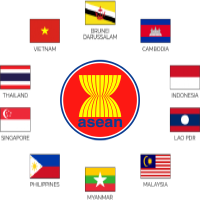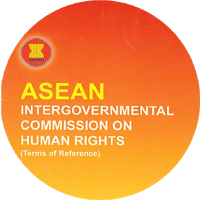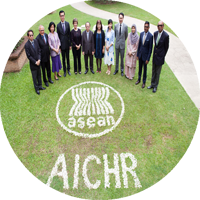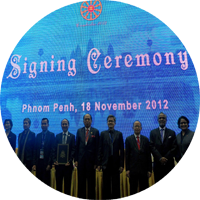The ASEAN Intergovernmental Commission on Human Rights (AICHR) was inaugurated by the ASEAN Leaders on 23 October 2009 at the 15th ASEAN Summit in Cha-Am Hua Hin, Thailand. This was further enhanced with the promulgation of the ASEAN Human Rights Declaration (AHRD), adopted in November 2012 with the Phnom Penh Statement on the Adoption of the AHRD signed by ASEAN Leaders. The establishment of the AICHR demonstrates ASEAN’s commitment to pursue forward-looking strategies to strengthen the regional cooperation on human rights. The AICHR is designed to be an integral part of ASEAN organisational structure and an overarching institution with overall responsibility for the promotion and protection of human rights in ASEAN.
The AICHR members are called Representatives, who are nominated by their respective Governments. Decision-making of the AICHR is based on consultation and consensus. Since its establishment, the AICHR has adopted several key documents, including the Guidelines on the Operations of AICHR and the Guidelines on the AICHR’s Relations with Civil Society Organisations (CSOs). The AICHR’s priority areas on human rights are found in the Five-Year Work Plan, which is based on the 14 mandates of the AICHR outlined in their TOR. Each year, the AICHR specifies their high priority programmes and activities for the year based on the Work Plan and in response to emerging exigencies on human rights in the region. The AICHR has completed its first Five-Year Work Plan 2010 – 2015.
The AICHR holds two regular meetings per year and additional meetings when necessary, and reports to the ASEAN Foreign Ministers.
History of Human Rights in ASEAN

July 1993
Joint Communique of the 26th ASEAN Foreign Ministers Meeting (26th AMM)
Marked the journey of the establishment of an appropriate regional mechanism of human rights in ASEAN; ASEAN Member countries participated at the UN World Conference on Human Rights, which adopted the Vienna Declaration and Programme of Action and at the subsequent ASEAN Foreign Ministers, ASEAN for the first time set itself towards the development of regional human rights regime.

November 2007
Adoption of ASEAN Charter
Promotion and protection of human rights are enshrined as one of the purposes and principles of ASEAN and its Member States. The ASEAN Charter highlighted the need of the establishment of human rights body outlined in Article 14, which states that “In conformity with the purposes and principles of the ASEAN Charter relating to the promotion and protection of human rights and fundamental freedoms, ASEAN shall establish an ASEAN human rights body”.

July 2008
Establishment of High Level Panel on ASEAN Human Rights Body
The High Level Panel on an ASEAN Human Rights Body drafted the Terms of Reference of ASEAN Intergovernmental Commission on Human Rights (the TOR of the AICHR).

July 2009
Adoption of TOR of the AICHR
The ASEAN Foreign Minister adopted the TOR of the AICHR which prescribes fourteen mandate and functions of the AICHR.

October 2009
Inauguration of the AICHR
The AICHR was inaugurated through the adoption of Cha-Am HuaHin Declaration on the Intergovernmental Commission on Human Rights, which states that ASEAN cooperation on human rights will continue to develop so that the AICHR will be the overarching institution responsible for the promotion and protection of human rights in ASEAN. Ten AICHR Representatives are appointed, one of each Member State.

November 2012
Adoption of ASEAN Human Rights Declaration
The adoption the ASEAN Human Rights Declaration and Phnom Penh Statement on the Adoption of the AHRD as the framework for regional cooperation on the promotion and protection of human rights are the embodiment of commitment of the Governments of ASEAN to safeguard the human rights and fundamental freedoms of the people of ASEAN.

